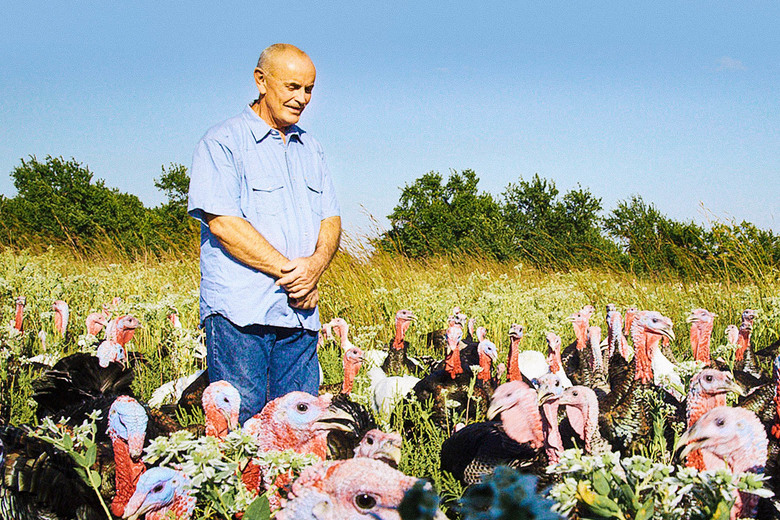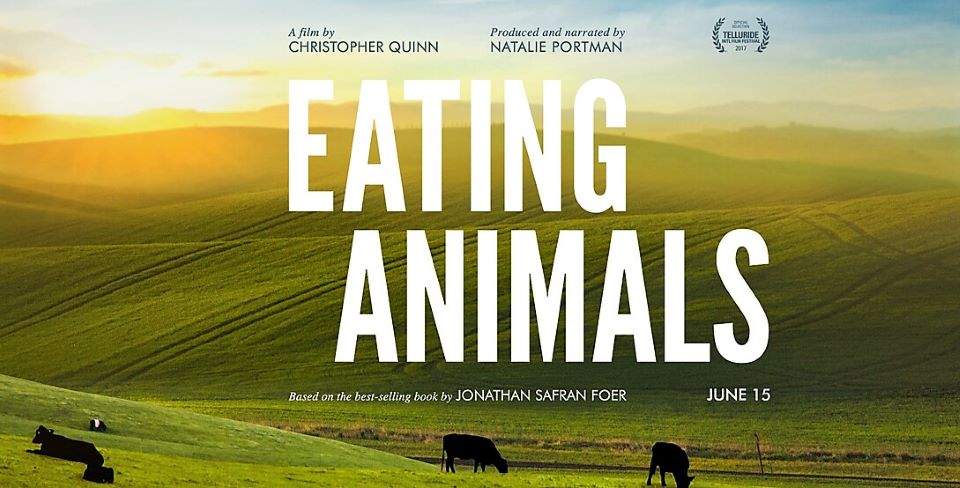Eating Animals, based on the bestselling novel by Jonathan Safran Foer, is an easily digestible and entertaining documentary that exposes factory farming as the real threat that it is. Directed and co-produced by Christopher Dillon Quinn with narration and co-production by actress Natalie Portman, the documentary covers a broad array of topics relating to factory farming, including several key entrepreneurs of the meat production industry and current practices in 99% of farms today, animal cruelty, and the small, independent heritage farms that are trying to keep traditional practices of farming alive. Eating Animals strives to educate consumers about how their meals actually get from the farm to their plates, revealing the system of abuse that is harming the environment, the animals, and the farmers.

Vanity Fair photograph of the main crew behind Eating Animals
The film epitomizes the monstrous factory farming industry and its devastating impact on the environment. Natalie Portman informs the audience through voice-over narration dozens of facts throughout the film, including how factory farming makes up 14.5% of human-caused emissions in history. Information like this is further illustrated through direct interviews, such as one done with a water activist in the south discussing issues of improperly farmed animal waste removal. The creation of fecal matter cesspools dumped near and running off into local rivers, aerial helicopter shots showing the luminescent pink sheen of the “hog lagoons”, and the unnatural color that appears to glow from them is shown as the water activist leader describes these devastating effects. The audience is then taken to the local waterways that are being directly impacted, images of rivers and lakes with rotting dead fish filling the screen. Photos of fish caught from these waters are then shown, revealing sores and entire chunks missing from their bodies due to the pollution.
Ag-gag laws are then discussed by the water activist and several other major individuals in the meat industry field, such as Temple Grandin. Ag-gag laws make it illegal for individuals to film the inside or outside premises of farms without that farm’s consent, which proves a large issue for people and non-profits that are aspiring to uncover the inhumane, unethical, and dangerous practices that modern day farms employ– like the immense water pollution described.
The animals in these limiting facilities live and die in cruel and inhumane ways, as shown in undercover footage retrieved from animal activist organizations. Quinn avoids using guilt tactics that many animal rights activist groups– like PETA –employ, instead using the undercover footage sparingly and set within a framework of facts in a more comprehensible and engaging way. Animal rights activists, scholars and farmers are also directly interviewed about the treatment of these animals and viewers get a better understanding of their daily lives and deaths. Issues about treatment range from how the animals are bred and fed to the grotesque means that lead to the animals being unable to properly walk and breathe, including the dirty, cramped, hazardous living conditions, the methods of breeding (repeated rape), and how they are often being carelessly slashed or beaten to death. An ethical treatment of animals cannot be maintained within the framework of factory farming, and that is made blatantly obvious through the footage in the film.

A shot from the film displaying a portion of a factory farm.
The last topic explored in the documentary is of the hardworking individuals that dedicate their lives to feeding the nation and their helplessness within the factory farming corporate world. Direct interviews with several farmers reveal the impoverished and fear ridden realities of their daily lives within the industry. The companies that own these farms continue to demand higher yields without increasing individual farmers’ profits while the price to farm only continues to skyrocket, force farms to compete against each other, and in turn isolate entire farming communities from one another. However, several brave whistleblowers are interviewed along with visiting several independent heritage farms, and hope arises. Although struggles are explored, the overwhelming feeling imparted on the audience by the end is one of optimism for a viable, long-term solution. It is refreshing to see these farms functioning outside the system and continuing to pass down traditional ways of farming in which both the animal and land are respected.
Factory farming is largely holding American farmers hostage, but Eating Animals does a fantastic job of showing the audience that there are other alternatives among the insidious nature of the Factory Farming industry. Farming corporations have done a masterful job of blinding America to the realities of current day farming practices, but by revealing its devastating tactics are destroying the environment, the lack of moral treatment of the animals, and the exhausting lives of the blue collared workers involved, there comes hope for change. This film inspires people to strive to make informed decisions about where the food on their table really comes from and how to put an end to the pain caused by such farming practices. To put it simply, in the words of one of the independent farmers, “Holiness is not doing great things, it’s doing small things with great love.”

A promotional shot from the film


Recent Comments